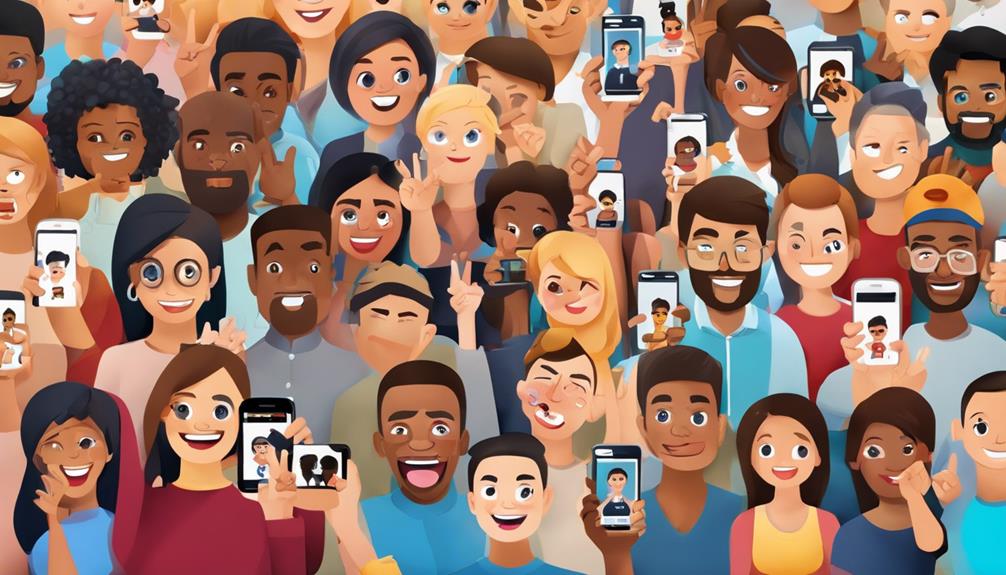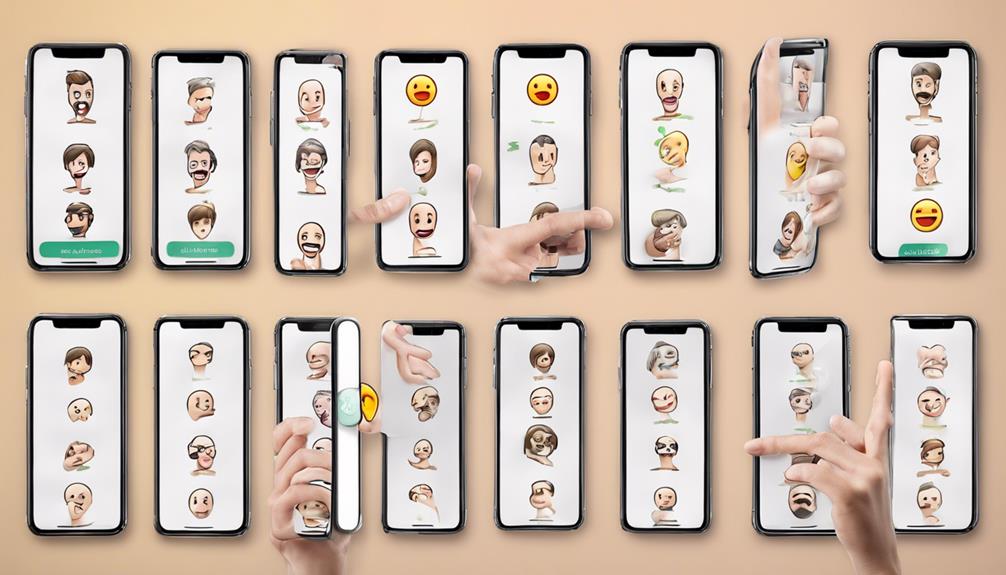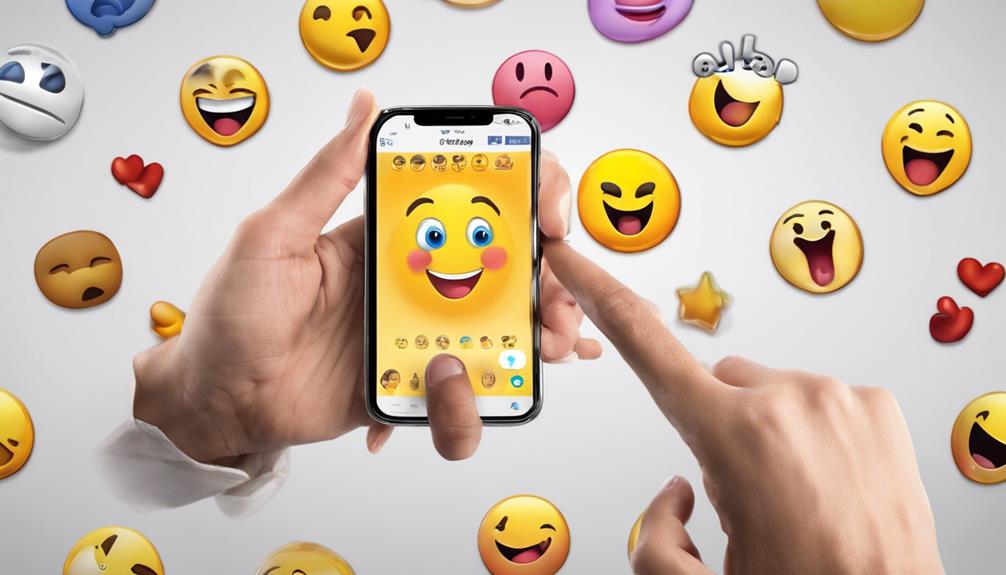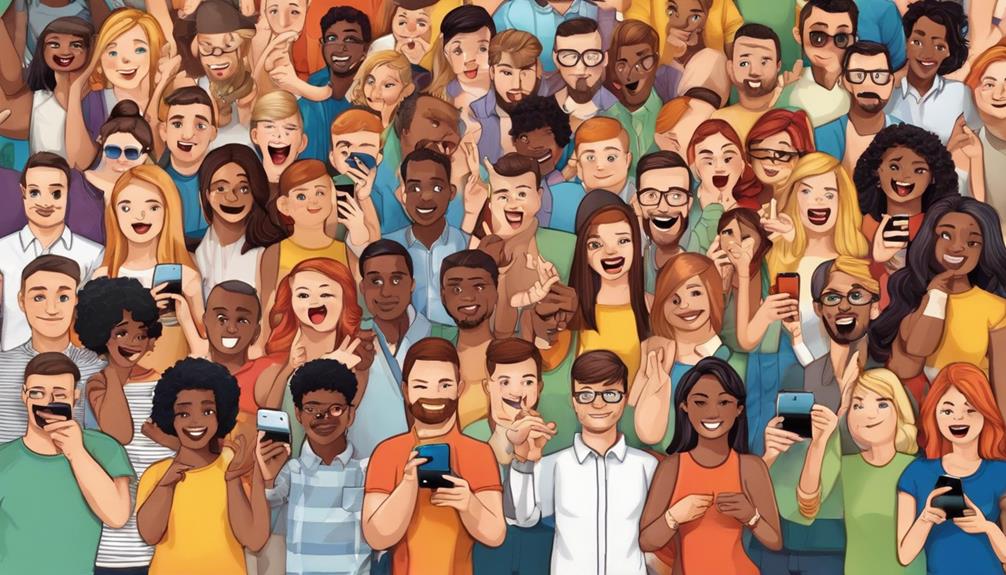In today’s digital age, emojis are becoming their own form of language. The development of 10 Emoji Sign Language Translator Apps is a creative solution to bridging communication gaps. These apps blend traditional sign language with modern digital symbols, making them appealing to a diverse range of users.
The potential for improved understanding and smoother interactions is evident, but what truly sets these apps apart is their innovative features and user-friendly interfaces. Let's explore how these tools are reshaping the way we connect and express ourselves in this evolving digital landscape.
Key Takeaways
- Emoji sign language translator apps enhance digital conversations by converting ASL signs into universally understood emojis.
- These apps bridge communication gaps, empower individuals with hearing impairments, and promote inclusivity in the digital environment.
- User-friendly interfaces and customizable features make these apps accessible and beneficial for users seeking expressive communication tools.
- The integration of sign language with emojis revolutionizes communication methods, fostering inclusivity and improving accessibility for all.
Signily Emoji Translator App
Signily Emoji Translator App revolutionizes communication for American Sign Language (ASL) users by seamlessly integrating a diverse collection of ASL signs into emoji form for enhanced expression.
This innovative tool translates complex ASL signs into universally understood emojis, bridging the gap between sign language and digital communication. Developed by ASL experts, Signily offers a comprehensive range of ASL signs in emoji format, enabling users to convey their thoughts, feelings, and messages visually with ease.
By providing a visual alternative to text-based messages, Signily Emoji Translator simplifies communication for ASL users, making it more inclusive and accessible. This app not only enhances digital conversations but also promotes understanding and empathy among users.
With Signily, users can express themselves more effectively, breaking down barriers and fostering a more inclusive communication environment.
EmotiSign Emoji Translator Tool

EmotiSign offers a range of features that simplify converting text and emojis into American Sign Language gestures.
The user-friendly interface makes it accessible to individuals looking to communicate effectively with the deaf or hard of hearing community.
EmotiSign plays a vital role in enhancing inclusivity and bridging communication gaps through Sign Language translations.
Features of EmotiSign
With EmotiSign, users can effortlessly translate text into sign language emojis for seamless communication. This emoji translation tool stands out due to its real-time translation capabilities, making it a valuable asset for individuals looking to enhance their communication experiences.
EmotiSign not only provides accurate translations but also allows users to customize their sign language emojis to better suit their preferences and needs. Moreover, the app supports multiple languages, fostering inclusivity and enabling users to communicate effectively across linguistic barriers.
User-Friendly Interface
Transitioning from the features of EmotiSign, users will find the user-friendly interface of the EmotiSign Emoji Translator Tool to be intuitive and accessible for seamless communication through sign language emojis. The tool's design prioritizes ease of use, allowing individuals to navigate effortlessly while translating text or audio into expressive emojis for enhanced communication. Users can personalize their virtual translators with preferred items and outfits, adding a touch of individuality to their interactions. Moreover, the option to save favorite translations for offline access ensures efficient communication at all times. With a remarkable 4.4 average rating and over 4 million downloads, EmotiSign stands out as a highly acclaimed tool for mastering sign language through the innovative use of emojis.
| Feature | Description |
|---|---|
| Intuitive Design | Easy to navigate interface for seamless emoji translation |
| Personalization | Customize virtual translators with favorite items and outfits |
| Offline Access | Save favorite translations for efficient communication even without internet |
Accessibility for All
Enhancing communication accessibility for all, the EmotiSign Emoji Translator Tool is designed to facilitate seamless conversion of text messages or spoken words into sign language emojis. This emoji translate tool ensures inclusivity by offering a visual representation of sign language gestures through emojis, aiding in better understanding.
Here are four ways EmotiSign promotes accessibility for all:
- Converts text messages into sign language emojis.
- Translates spoken words into sign language gestures.
- Bridges communication gaps between sign language users and others.
- Provides a free platform for enhancing communication accessibility.
EmotiSign contributes to a more inclusive and accessible communication environment, empowering individuals with hearing impairments to express themselves effectively.
SignEase Emoji Translation App

The SignEase Emoji Translation App simplifies communication by translating text or spoken words into customizable sign language emojis. This innovative tool caters to the growing need for inclusive communication by allowing users to express themselves effectively through sign language emojis.
Whether you're looking to enhance your social media posts with unique emojis or convey messages using a visual language, SignEase has you covered. By offering the ability to translate text to emoji, this app opens up a world of possibilities for users seeking to diversify their communication methods.
The option to customize emojis and save favorite translations ensures a personalized experience tailored to individual preferences. With its user-friendly interface and seamless functionality, SignEase makes learning and using sign language emojis accessible to all, making it an invaluable resource for those looking to communicate with clarity and creativity.
GestureTalk Emoji Translator

Moving from SignEase Emoji Translation App to GestureTalk Emoji Translator, we encounter a specialized tool that translates sign language gestures into emojis, facilitating effective communication between diverse language users. This innovative app, developed by Claudio Costa, offers a unique solution to bridge the communication gap by converting sign language gestures into easily understandable emojis. Here are some key features of GestureTalk Emoji Translator:
- Sign Language Translation: Users can input sign language gestures into the app.
- Emoji Conversion: The app then translates these gestures into corresponding emojis.
- Enhanced Expression: This feature makes it easier to express thoughts and emotions visually.
- Accessibility and Inclusivity: GestureTalk Emoji Translator promotes understanding and communication between sign language users and emoji users, contributing to a more inclusive digital environment.
Claudio Costa's app has been well-received for its user-friendly interface, practicality, and its role in fostering comprehension across different forms of communication.
HandSign Emoji Translation Tool

We're excited to introduce the HandSign Emoji Translation Tool, a user-friendly app that offers quick emoji translation for effective communication.
With its intuitive interface, users can easily convert text or audio into sign language emojis.
This tool seamlessly integrates sign language, enhancing communication experiences for all users.
Quick Emoji Translation
Navigating the world of emojis just got more inclusive with the HandSign Emoji Translation Tool, a quick and accurate way to convert emojis into sign language for effective communication. The tool offers a seamless experience for users to translate emojis into hand signs, enhancing understanding and inclusivity in digital communication.
Here are some key features of the HandSign Emoji Translation Tool:
- Quick and accurate emoji to sign language translation.
- Support for multiple sign languages for comprehensive options.
- User-friendly interface for easy conversion.
- Enhances communication by bridging the gap between emojis and sign language.
Experience the power of emojis in sign language communication by clicking the blue button on the emoji translator today!
User-Friendly Interface
As we explore the functionality of the HandSign Emoji Translation Tool, the user-friendly interface stands out for its simplicity and effectiveness in facilitating communication through sign language emojis.
The app offers a seamless experience, allowing users to navigate and interact effortlessly. Accessing the emoji translation features is straightforward, with clear icons and intuitive design elements. This simplicity ensures that users can communicate smoothly using sign language emojis without encountering any technical complexities.
The user-friendly interface enhances the overall accessibility and effectiveness of the app, making it a valuable tool for those looking to engage in sign language communication. With its focus on ease of use, HandSign Emoji Translation Tool prioritizes a positive user experience for seamless communication.
Sign Language Integration
Integrating sign language seamlessly into emojis, the HandSign Emoji Translation Tool revolutionizes communication accessibility and inclusivity. Sign language integration with emojis using this tool helps bridge communication gaps by:
- Allowing users to express sign language through familiar emoji symbols.
- Providing a unique learning experience for users to understand sign language expressions.
- Enhancing digital conversations by combining the visual appeal of emojis with the depth of sign language.
- Facilitating smoother communication experiences between sign language users and others.
This innovative approach not only fosters inclusivity but also empowers individuals to communicate more effectively across different modes of expression.
ASL Emoji Convert App

The ASL Emoji Convert App simplifies communication by translating text or audio into American Sign Language (ASL) emojis. Users can input phrases through typing or speaking, allowing the app to convert them into ASL emojis for smoother interactions. Moreover, the app provides customization options, enabling users to personalize virtual translators by selecting favorite items and backgrounds. This customization feature adds a personal touch to the communication process, making it more engaging and user-friendly. Additionally, the app allows users to save their favorite translations offline, ensuring easy access whenever needed. The ASL Emoji Convert App is free to download and use, with an option to pay for ad removal for an uninterrupted experience.
| Feature | Description |
|---|---|
| Translate Text | Input text or speak phrases for the app to convert into ASL emojis |
| Customization Options | Personalize virtual translators with favorite items and backgrounds |
| Save Favorite Translations | Save and access preferred translations offline for convenient use |
FingerTalk Emoji Translator

Exploring the FingerTalk Emoji Translator app reveals a user-friendly platform for translating text or audio into sign language emojis. Here are some key features that make this app stand out:
- Big Blue Button: The app features a prominent 'big blue button' that users can easily tap to initiate the translation process, making it simple and intuitive to use.
- Emoji Translator: FingerTalk allows users to input text or even speak into the app for quick translation into expressive sign language emojis, enhancing communication with the deaf community.
- Sign Language Emojis: Users can access a variety of sign language emojis to convey their messages effectively, bridging the communication gap between different language users.
- Customization Options: In the app's store, users can personalize their virtual translators with different outfits and backgrounds, adding a fun touch to their communication experience.
The FingerTalk Emoji Translator app provides a convenient way to translate text or audio into sign language emojis, offering a valuable tool for easy and effective communication.
HandWave Emoji Translation App

Upon exploring the HandWave Emoji Translation App, we discovered a user-friendly platform designed to facilitate communication through sign language emojis. This app offers a seamless experience for translating text or audio into expressive sign language emojis, enhancing communication for users. The user-friendly interface allows for easy customization of characters, saving translations, and accessing favorite translations offline, making it convenient for daily use.
Users have lauded the HandWave Emoji Translation App for its role in not only aiding communication but also for helping individuals learn sign language effectively. This app serves as a valuable tool for those looking to bridge communication gaps and immerse themselves in the world of sign language.
Available for free on both the App Store and Google Play Store, the HandWave Emoji Translation App stands out as a practical and accessible resource for anyone seeking to communicate using sign language emojis in a user-friendly manner.
SignEmoji Communication Tool

Let's take a closer look at the SignEmoji Communication Tool and explore its app features and user experience for effective communication using sign language and emojis.
By comparing this app to others in the market, we can gain insights into its unique offerings and how it stands out in facilitating sign language communication.
Understanding the nuances of SignEmoji can help us appreciate its role in bridging communication gaps and enhancing inclusivity through innovative technology.
App Features Overview
The SignEmoji Communication Tool seamlessly merges sign language and emojis to enhance communication experiences for users. Here's an overview of the app features:
- Expressive Communication: Users can combine sign language and emojis to convey emotions and messages effectively.
- Learning and Practice: The app allows users to learn and practice sign language while incorporating emojis into their conversations.
- Customizable Avatars: Users can personalize their avatars, adding a personal touch to their communication.
- Translation Options: The app offers translation options, making it easier for users familiar with both sign language and emojis to bridge communication gaps.
These features make the SignEmoji Communication Tool a unique and valuable tool for enhancing communication experiences.
User Experience Comparison
Comparing user experiences with the SignEmoji Communication Tool reveals its seamless integration of sign language and emojis for enhanced communication. The tool's feature allowing customization of skin tones ensures inclusivity and accurate representation.
Users appreciate the user-friendly experience, with intuitive input methods for text translation. The support for multiple languages caters to a diverse user base, enhancing accessibility. Additionally, the tool's ability to simplify complex ideas into visual representations through emojis aids in effective communication.
The inclusion of Super Emoji further enhances the user experience by offering a wider range of expressive icons. Overall, SignEmoji Communication Tool excels in providing a versatile and inclusive platform for users to communicate effectively using a combination of sign language and emojis.
ExpressSign Emoji Translator App

Excited to explore how the ExpressSign Emoji Translator App revolutionizes communication through sign language and emojis. This innovative app seamlessly combines these elements to enhance expression and clarity in a user-friendly interface. Here are four key features that make the ExpressSign Emoji Translator App stand out:
- Effortless Translation: Users can easily translate text or speech into sign language gestures using a variety of emojis as visual aids.
- Customization Options: The app allows users to personalize their sign language translations by selecting from a wide range of emojis, ensuring a tailored and expressive communication experience.
- User-Friendly Interface: With a simple and intuitive interface, navigating the app is a breeze, making it accessible to individuals of all tech proficiency levels.
- Inclusivity and Innovation: By bridging communication gaps and promoting inclusivity, the ExpressSign Emoji Translator App showcases the power of technology to revolutionize the way we communicate.
Frequently Asked Questions
Is There an App That Converts Sign Language to Speech?
Yes, there isn't an app that converts sign language to speech.
Sign language apps, like Hand Talk, translate text or audio into Sign Language, not speech. They support English to American Sign Language (ASL) and other language translations.
Users can input text or speech to have characters in the app translate to their chosen Sign Language. Customization options and offline access for saved translations are available too.
Is There an Emoji Translator?
Yes, there's an emoji translator! It converts emojis to text and vice versa for effortless communication.
This tool simplifies expressing thoughts through visual symbols, aiding in better understanding.
Users can even customize skin tones and languages for accurate translations.
Emoji translators play a crucial role in bridging communication gaps, making it easy to decode and convey messages effectively.
What Phone App Translates Signs?
We found an excellent phone app that translates signs! It's the Hand Talk app, a popular tool with over 4 million downloads and a stellar 4.4-star rating.
This app converts sign language into text or audio, aiding communication for deaf individuals. Users can even personalize their virtual translators, Hugo and Maya.
Plus, you can store favorite translations for offline use. It's a fantastic resource for learning sign language and connecting with the deaf community.
Is There Google Translate for Sign Language?
Yes, there isn't a Google Translate specifically for sign language. However, apps like Hand Talk can help with this need.
Hand Talk, recognized by the UN, offers translation services for ASL and Libras.
With over 4 million downloads and a 4.4 user rating, users can learn sign language by typing or speaking phrases.
Conclusion
In conclusion, these 10 emoji sign language translator apps offer a convenient way to bridge communication gaps and enhance understanding.
An interesting statistic to note is that over 5 million people worldwide are estimated to use sign language as their primary means of communication.
With the availability of these apps, communication barriers can be broken down, allowing for more inclusive and accessible interactions for all.











